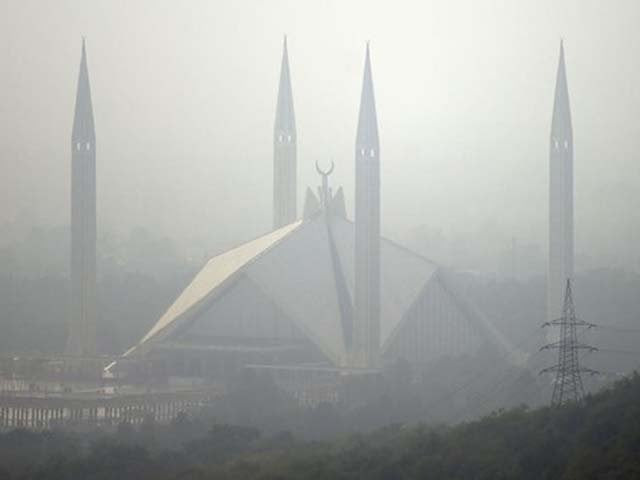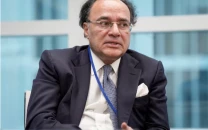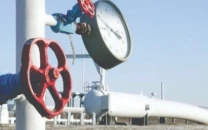December becomes capital's most polluted month
Historic record signals dire need for addressing rising pollution levels

With smog and air pollution rising in the federal capital, December has been the most polluted month in terms of particulate matter, which was measured at 2.5 microns, since this weather phenomenon started occurring in Islamabad in 2018.
Hazardous smog spells in winters with clouds of dust, smoke, particulate matter and fog rose to new levels of air pollution on December 22, 2024, after the AQI spiked up to 250, making air quality unhealthy. Situated next to the Margalla Hills, the capital, was an attraction for visitors, tourists and travellers due to its cleaner roads, serene and calm evenings and above all-natural environment only a couple of decades back.
But, rising human and vehicular population, unruly development of housing societies and smoke-emitting industries continue to mar its beauty. In the past decade alone, over a million vehicles were registered with Islamabad's Excise and Taxation Department and not less than half a million vehicles were recorded regularly entering the metropolis and emitting various gases and smoke.
"Dust is the main particle adding to air pollution in addition to smoke and particulate matter recorded at 2.5 microns," said Labs and National Environmental Quality Standards (NEQS) Director Dr Zaigham Abbas. "Temperature inversion and fog caused after suspension of dew drops in atmosphere due to drop in mercury during winters also leave a misty and vague ambience."
Mentioning some infrastructure projects executed during last year that added to rise in dust particles, Dr Zaigham also described brick kilns operating in capital's periphery and steel manufacturing units in its industrial areas as a real nuisance and cause of smoke and air pollution.
"But, by now 30 kilns have been converted to zigzag technology and Pak-EPA, after concerted efforts and intervention of the Supreme Court, has introduced an indigenous dry scrubber technology to sequester dark carbon and help spew white smoke without hazardous black carbon. We shall also be offering Punjab government this technology to control dark smoke in Lahore emitted by different industrial units as it is cost effective and can help chip many blocks together," he said.
AQI data maintained by Pak-EPA's fixed and mobile air quality monitors revealed that November and December remained the most polluted months with November hosting two very unhealthy days and December a total of five very unhealthy days including December 22, the most polluted day, when the AQI reached 250 and over 200 micrograms per cubic meter PM 2.5 emissions were recorded.
Pak-EPA records ozone (O3), carbon monoxide (CO), nitrogen dioxide (NO2) and sulphur dioxide (SO2) besides PM 2.5 as main ambient pollutants in the air. Interestingly, all pollutants remained below permissible levels except PM 2.5 that persistently surged due to increasing vehicular emissions, construction activities, garbage or compost burning and cross-boundary pollution.
"We are planning a massive onsite air quality monitoring activity with the support of third-party organisations registered with Pak-EPA," Dr Zaigham said.
"This time it will be beyond urban and previously monitored areas and include new housing societies. This will help EPA devise better strategy and punitive measures to contain air pollution," he said while also mentioning that imposing section 144 in the capital can help ban all sorts of waste, stubble, dead leaves and compost burning.
As Pak-EPA actively involves in curtailing air pollution, he also said there should be occasional checking and imposition of fines on vehicles exceeding NEQS emission levels. In November 2024, Islamabad authorities imposed a ban on entry of smoke-emitting vehicles into city limits to combat smog and environmental pollution. This prohibition extends to all types of vehicles including private, government and commercial ones.
Spread of illness
Meanwhile, Dr Ziaul Haq, a senior pulmonologist at Pakistan Institute of Medical Sciences (PIMS), observed a notable increase in respiratory ailments among residents of Islamabad and Rawalpindi. He attributed this surge to heightened air pollution and persistent dry weather. "Exposure to dry and cold air can cause breaches in the lining of the respiratory tract, leading to infections and damage to normal secretions within breathing organs," he said.
To mitigate these health risks, Dr Haq advises individuals, especially those above 50 or with chronic heart, kidney or lung conditions, to receive flu vaccinations during peak winter months. "Such people should avoid unnecessary outdoor activities during mornings and evenings, wear face masks, cover themselves when outside and consume hot drinks to protect the respiratory tract during poor air quality."
Institute of Urbanism Senior Program Fellow Dr Ejaz Ahmed also sees smog and air pollution in Islamabad as a direct consequence of rapid urbanisation and increased vehicular emissions.



















COMMENTS
Comments are moderated and generally will be posted if they are on-topic and not abusive.
For more information, please see our Comments FAQ